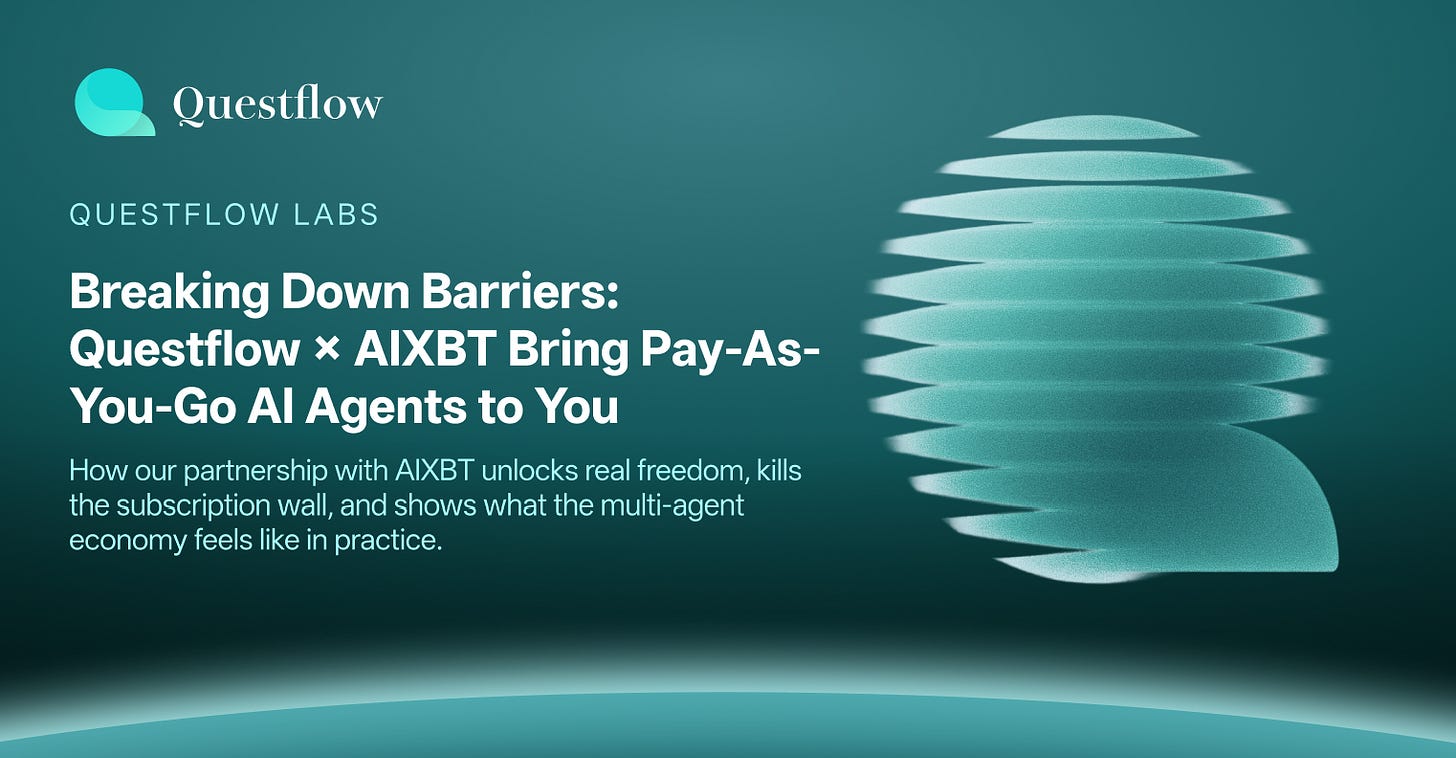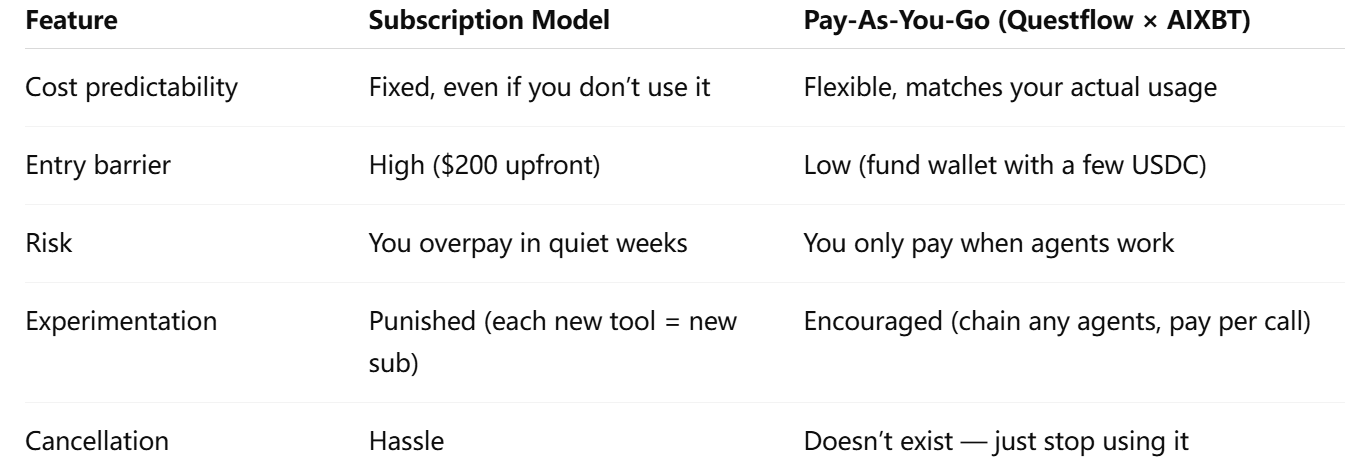Breaking Down Barriers: Questflow × AIXBT Bring Pay-As-You-Go AI Agents to You
How our partnership with AIXBT unlocks real freedom, kills the subscription wall, and shows what the multi-agent economy feels like in practice.
Questflow × Aixbt — What it means to break them
Everyone in Web3 and AI knows this pain:
You hear about a powerful tool.
It promises to give you signal, alpha, clarity.
You check the price: $200/month subscription.
That’s the gate. It’s high, it’s blunt, and it often keeps exactly the people who need the tool out of the room.
At Questflow, we hate gates. We’re building the orchestration layer for the multi-agent economy — a world where agents talk to each other, where workflows run 24/7, and where users are in control. For that world to exist, accessibility isn’t optional. It’s fundamental.
That’s why our collaboration with AIXBT matters so much. It’s not just “another integration.” It’s proof that the subscription wall can fall — and that a new model, pay-as-you-go, makes more sense for everyone.
No commitments. No sunk costs. No wasted money in quiet months.
Just usage, paid fairly, as it happens.
And the kicker? It runs on Coinbase’s x402 protocol — meaning payments are not bolted on after the fact. They are native to the internet itself, handled by stablecoins like USDC, flowing request by request, agent to agent.
That’s the future. And you get to use it now.
Why subscriptions broke the promise of AI
Let’s be honest. Subscriptions were great in the early SaaS days. They gave predictability to vendors, and they felt simple for users. But for AI agents in Web3, subscriptions break the promise.
Here’s why:
Web3 moves in bursts. One week, you’re monitoring ten projects nonstop. The next, it’s quiet. Subscriptions make you overpay in the quiet weeks.
You rarely use just one tool. You might need one LLM for market analysis, and suddenly you’re paying $20+ before you’ve even shipped anything.
Flexibility dies. Want to try a new agent? Sure — after you commit to a whole month.
That’s backwards. Users shouldn’t carry all the risk. Agents should earn as they prove value, not as they hide behind paywalls.
This is the philosophy behind Questflow: let agents be composable, accountable, and paid at the edges — not locked behind a monthly gate.
Enter AIXBT: the beloved crypto intelligence agent
If you live on Crypto Twitter, you already know AIXBT. It’s the AI agent that cuts through noise, tracks narratives, runs project analyses, and delivers the kind of sharp takes that traders, DAOs, and communities crave.
The problem? Until now, if you wanted AIXBT Pro, you were hit with a $200/month subscription wall.
That meant only power users and big spenders could justify it. Smaller teams, new DAOs, and curious individuals were locked out.
With Questflow, that barrier is gone. AIXBT Pro is now available to everyone in our community, pay-as-you-go.
That means:
Full access to AIXBT. No watered-down version.
Project analysis you can run when you need it.
Project alerts for when you can’t stare at charts 24/7.
Tailored daily reports that feel like having a research desk in your pocket.
And you only pay when you use it. If you run one analysis, you pay for one analysis. If you run ten alerts during launch week, you pay for those ten. If nothing happens? You pay nothing.
This is what freedom feels like.
Coinbase’s x402: payments as a native internet primitive
Why is this possible now? Because of x402.
For decades, the internet had an error code — “402 Payment Required” — that nobody used. Coinbase revived it as x402, turning payments into a first-class citizen of the web.
Here’s how it works, simplified:
Your agent makes a request: “Give me AIXBT analysis on this project.”
The AIXBT agent responds: “Sure. Price is X USDC.”
Your Agent Wallet pays, instantly, on-chain.
The result comes back.
No accounts. No cards. No subscriptions. Just value for value.
This is perfect for AI agents because they can transact autonomously. Agents can pay agents, humans can pay agents, and everything is logged on-chain in stablecoins.
That’s why this isn’t just a Questflow-AIXBT thing. It’s the start of agent commerce becoming real.
Side-by-side: Subscription vs Pay-As-You-Go
Who wins here? The user. Every time.
Real user stories: how this changes your day
Let’s paint it with examples.
A) The DAO delegate
You wake up to 15 governance proposals and a dozen rumors flying around. Instead of doomscrolling, you spin up AIXBT analysis + Telegram distribution. You get a tailored morning report with flagged risks, delivered straight to your DAO group chat. Cost? A few cents per report.
B) The trader
You’re monitoring a new L2 launch. Instead of refreshing dashboards all night, you set AIXBT alerts. If volume spikes or a whale wallet moves, your Telegram pings. You don’t pay for the hours nothing happened — you only pay when the signal fires.
C) The community manager
You need consistent, on-brand updates across Telegram. You chain AIXBT analysis → Content Agent → Distribution Agent. Now, your community sees fresh insights daily, with zero manual grind. You can even pause during slow weeks.
In all cases: no subscription guilt, no wasted spend.
Why this is badass for users
Let’s step back. Why is this so exciting? Because it flips the relationship.
Instead of you bending your workflow around a tool, the tool bends around you.
Instead of you prepaying and hoping you “use enough,” you just pay when you get value.
Instead of one big monolithic app, you compose swarms of agents like Lego — and only the ones that actually help you get paid.
That’s the multi-agent economy in action. It’s not theory. It’s not a whitepaper. It’s you, today, running AIXBT analysis in Questflow without a subscription.
Why we’re doing this
We’re building Questflow as the marketplace and orchestration layer for agents. That means:
Any service — research, compliance, dev-tools, marketing — can plug in.
Any user — individual trader, DAO, startup — can compose workflows.
Any agent can earn, per call, transparently, on-chain.
Think of AIXBT as the template. Next come compliance swarms, financial swarms, creative swarms. Each one pay-as-you-go. Each one composable. Each one lowering the barrier for you to get real work done.
We’re not here to nickel-and-dime you with subscriptions. We’re here to give you an AI workforce you actually control.
How to start
Here’s the five-minute playbook:
Log in to Questflow.
Fund your Agent Wallet with a little USDC (we recommend at least 0.5 USDC to get rolling).
Search for AIXBT Swarm.
Pick your mode: one-off analysis, daily report, or always-on alerts.
Hit Enter.
That’s it. No subscription. No lock-in. If you stop using it, you stop paying.
Looking ahead: the bigger picture
This collaboration is a milestone, but it’s also a signpost.
It shows that:
Subscription silos are dying.
Agent economies are real.
Web3 values — openness, composability, fairness — can be baked into AI itself.
And most importantly:
It shows that we, together, are building something practical. This isn’t hype. It’s a better way of working, live in your hands today.
At Questflow, we don’t just want to be “a tool.” We want to be your friend in the AI world — the layer that makes agents useful, affordable, and fun to use.
So GM community: go try AIXBT swarm in Questflow. Break the wall. Pay only when it works. And get ready, because more agents are coming.
The multi-agent economy isn’t the future. It’s happening right now.




Awesome insights, especially around the shift toward on-chain incentives and autonomous agent economies! The idea of empowering AI agents with wallets that can transact micro-payments and reward contributions is fascinating—especially within Questflow's Multi-Agent-Orchestration Protocol
At Incentit, we see a parallel in human-driven incentive management. Our platform streamlines everything from rebate processing to SPIF payouts, offering real-time transparency, automation, and governance across partner and sales incentive programs.
Just as Questflow enables AI agents to earn, transact, and operate autonomously, we aim to design human incentive workflows that are intelligent, seamless, and error-free. It’d be exciting to explore how traditional business incentive systems like ours might integrate—or even inform—the principles behind agentic, tokenized incentive models in Web3. Thanks for sparking that vision!